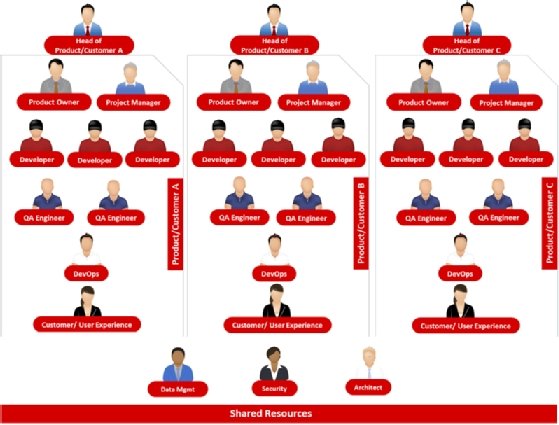
mckaphoto - Fotolia
An IT operating model for the digital age
Enterprises need to form cross-functional teams and give them the mandate to work together towards a single goal
Speed and innovation are at the core of any successful business today. With power put increasingly into the hands of digital-savvy, fickle customers, the pressure to continuously improve products and services has never been greater. If they are not delighted by each and every interaction with a brand, today’s customers simply move on at the click of a button or swipe of a screen.
For digital-native businesses – such as Spotify or Amazon Web Services – this competitive, customer-focused spirit is in their lifeblood. But otherwise, most traditional businesses today are not set up to deliver a great customer experience. Bogged down by traditional organisational models, they are structured more around cost efficiencies than innovation.
Consider a typical IT team – generally, all tech staff will sit in their own division, removed from the rest of the business because it is easier to track, manage and budget their work. What happens, then, if the head of customer experience has a request?
It is unlikely that customer experience teams, which have different key performance indicators (KPIs), will have much interaction with IT. The result is two frustrated parties lacking a common language and unable to deliver innovation at the pace required by customers and the wider business.
The challenge is to reorganise team structures in a way that allows innovation to flourish. In the era of digital transformation 1.0, that meant a bolt-on or “bi-modal” approach to digital, essentially giving a dedicated team the resources and licence to operate at pace, while the rest of the business continued plodding along in a traditional environment.
It is not a bad place to start to get digital initiatives prioritised, but the reality is that “digital” now impacts every transaction and every touchpoint.
For example, even if customers go into a bricks-and-mortar store, they are likely to have researched products and compared prices beforehand. Meanwhile, on the business side, sales and marketing teams are now using aggregated data insights to inform their campaigns in the hope of shortening sales cycles.
Or how about airline passengers – how many people now go into a travel agency to book a flight? These days, we can book our flight, seat, meals and luggage online, as well as check in before we even get to the airport.
Work together for a united goal
This means that a one-dimensional team is not enough to change or affect customer experiences. Instead, businesses need to gather people from across their organisation – product, customer experience, distribution and, of course, IT – who have different metrics, budgets, priorities and timelines, and give them the mandate to work together towards one united goal.
In an airline, that might mean moving from a structure where logistics, ticketing, loyalty, IT, project management, customer lounges, check-in and baggage are all dealt with by a single team called “pre-flight experience”. Every time a change needs to be made to the customer experience before the flight, all the roles that can affect that change can come together easily, knowing that they share the same goals and are driving towards the same outcome.
It is a divide-and-conquer approach – instead of putting all your IT eggs in one basket, you send them into the product and experience teams to develop and improve digital services on the ground. The new structure of IT teams would have:
- Product and project managers working side-by-side, complementing each other’s skillsets while overseeing the process of developing and improving products, services and experiences.
- Developers embedded in the teams, sitting alongside quality assurance to ensure the development of digital services is not slowed down unnecessarily.
- DevOps providing the cloud infrastructure and platform services as required.
- Customer/user experience teams, working closely with tech to ensure final products and services are easy and intuitive to use, and delight the customer.
- Data management shared across teams to ensure insights are not siloed, but rather treated as a product and integrated throughout the business.
- Architecture as a guiding function, constantly evolving and improving capability that makes the business better, more efficient and faster.
- Security, often shared across teams, and given the ultimate power to say “no” if a product could compromise customers, employees or the business itself.

But where should businesses start? Ultimately, the power to drive change lies in the hands of the CIO, but will require collaboration across the c-suite as business leaders adapt their relationship with IT and determine team KPIs. It is also important to provide training to help employees prepare for the new structure.
Once in place, this model could well change the face of IT teams as we know them. For technology leaders, the role of CIOs will inevitably evolve – whether they become a technical leader, run innovation and invention functions, or take responsibility for delivering revenue and/or customer outcomes.
CIOs who are ahead of this change will be able to shape their role going forward based on their profile – but it is worth noting that those who have change forced upon them will rarely be in a position to be masters of their own destiny.
Read more about IT management
- Industrial giant GE offers lessons on its digital journey and what CIOs heading in the same direction need to know.
- Business leaders say their human resource IT programmes are leading the way to the wider deployment of digital and cloud technology across their organisations.
- Singapore’s DBS Bank laid the foundation for its digital strategy a decade ago, starting with an overhaul of its IT systems before going big on cloud computing in later years.
- Most IT decision-makers think the business takes too long to make decisions on digital transformation, a new study by Dimensional Research for Alfresco has found.
On the flipside, for technology suppliers, this model is likely to bring challenges. Bringing business and technology buyers together into one team should shorten the sales process – but it will also make it harder to find the right buyer in the first place.
To complicate matters further, with a focus on delivering continuous customer value, buyers are likely to require specialised solutions tailored to their unique needs and goals. Suppliers will therefore have their work cut out to better understand their customers and the outcomes they are trying to drive, in order to make the sales process smoother.
This new model of delivering continuous customer value is not perfect – it has inefficiencies, and moves away from focusing on big-ticket inventions towards smaller, everyday innovations. But it is only by becoming a fast and evolving business that companies will maximise their IT and digital capacities.
Tim Sheedy is principal adviser for cloud, artificial intelligence and customer experience at Ecosystm, a Singapore-based technology research firm










